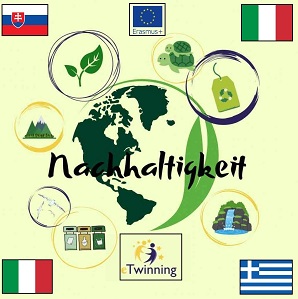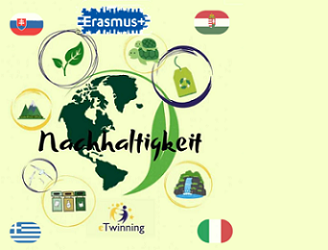

Gemeinsam die Zukunft gestalten- nachhaltig die Welt mitgestalten und Veränderungen vorantrieben- Shapingthefuturetogether – helpingtoshapetheworldsustainablyanddrivingchange
2023-2-HU01-KA220-SCH-000169980
The LICEO LINGUISTICO ‘ENRICO FERMI’ in Sciacca launched the Erasmus Plus project in German entitled ‘Shaping the future and the world sustainably together and leading change’.
The activities took place during the week of 21-25 October, an important initiative that welcomed 24 students and their teachers from Hungary, Slovakia and Greece and transformed the school into a lively centre of cultural exchange.
The project began in July last year with a teacher mobility in Hungary, where representatives from the four countries involved agreed and detailed the activities to be carried out. The German teachers Maria Miceli and Christakopoulou-Trisevgeni are coordinating this important exchange together with the school headmaster Maria Paola Raia.
The project, which spans two school years, has environmental sustainability as its central theme. The participants from the three countries were greeted with a welcome ceremony in the school auditorium, during which the pupils sang Beethoven’s Ode to Joy in German, a symbol of the values of peace and fraternity that characterise the European Union. The school band added a special touch to the event by creating an atmosphere of togetherness and celebration. The participants received a T-shirt with the project logos, a symbolic gesture that symbolises the unity and cooperation between the different cultures.
The theme that we developed in the workshops at school and during the guided tours has to do with water. We addressed the issue of sustainable management of water resources, which is crucial for our planet, especially in times of climate change. We focused on activities that help to sensitise young people to the need to conserve and use water responsibly.
The activities planned for the first meeting in Sicily included laboratory-based educational activities at school, where students worked together in special workshops on sustainability, got to know each other and learnt a foreign language. These activities were carried out:
– Multimedia presentations: ‘Partner schools introduce themselves’.
– Presentation and evaluation of the results of the questionnaires on the ‘Ecological Footprint’ of all partner countries in the Aula Magna in plenary session
– Group work ‘The history of sustainability’ in the Aula Magna
– Interactive Italian lesson with games in the Aula Magna
– Participation of pupils and teachers in class lessons
In addition to the work in the school, excursions were also organised to local sites with concrete examples of sustainable management. These visits allowed us to see how theoretical solutions can be applied in reality:
– Visit to the ‘Lago Arancio’ reservoir and dam and explanation by an engineer of how the structure works and the problems caused by the drought;
– Visit to Sambuca di Sicilia, the art gallery of the Gianbecchina institution and the archaeological museum of the Panitteri Palace;
– Workshops on environmental education with the environmental organisation ‘Marevivo’ Sicilia at the ‘Baia del Corallo’ in Sferracavallo:
– Workshop on marine biology and marine biodiversity, observation and explanation of the effects of anthropogenic impacts and climate change in the sea; development of solutions for more sustainable management of marine resources and more effective conservation of marine biodiversity;
– Virtual diving activities on the island of Ferdinandea through the use of OculusVisors;
– Guided tour of the ‘Trapezoidal Pier of Palermo’ by the architect and engineer who realised the ambitious redevelopment project and transformed this area into a fascinating attraction that combines history, culture and entertainment;
At the trapezoidal pier in Palermo, we heard from the planners of the recently completed urban regeneration project in the context of the harbour. The trapezoidal pier project is part of a wider redevelopment of Palermo’s urban harbour area being pursued by the city’s port authority. In particular, this latest intervention, the largest ever carried out on the coast, has made it possible to restore a large area characterised by the presence of an important monument: Palermo’s maritime castle. A public park was created in this area, giving back to the citizens a space that had been characterised by decay and pollution for more than fifty years. To carry out this intervention, numerous areas and several layers of asphalt had to be removed to allow the soil to breathe again. In addition to this intervention, the project envisaged transforming a large area into a public space by introducing public, commercial and nautical functions. The project is characterised above all by the presence of a large water basin that ideally brings the sea back into contact with the castle walls. This large urban lake, characterised by water features, is also intended to pay homage to the Arab tradition, widespread in Palermo, of water surfaces with aesthetic-decorative purposes. The trapezoidal pier reconnects the city with the sea and thus with its specific identity.
– Panoramic view of the ‘Scala deiTurchi’ at Realmonte;
– Guided tour of the ‘Kolymbethra’ garden in the Valley of the Temples.
Historical irrigation water in the Kolymbethra garden.
Water is a vital resource for humanity, but it is a scarce resource that must be valorised and defended through collective actions to save, recover and recycle. As part of the awareness-raising campaign, the FAI (Fondo Ambiente Italiano) has analysed exemplary cases of water management.
When thinking about water and the places that the FAI takes care of, the Giardino della Kolymbethra in the Valley of the Temples in Agrigento is undoubtedly one of the most important.
Water, in fact, is not only the reason for its foundation, but also the etymological origin of this property: the word ‘kolymbethra’ means ‘pond’ in Greek, and the Vallone della Badia Bassa (where the garden is located today) was so named. In the time of the Greek city, it was a kind of fish farm where swans and other birds lived. This is how DiodorusSiculus describes the Kolymbethra, an extraordinary public building of ancient Akragas (5th century BC), traces of which are still preserved in the Phaeacian aqueducts, water pipes dug into the rock (hypogea), which are still largely in operation today and supply the water that is important for agriculture.
In an area very poor in water and therefore naturally unsuitable for the cultivation of citrus fruits and vegetables, that of Agrigento, the Kolymbethra Valley is an even more unique place thanks to its morphology and the presence of these hypogea, which still collect the deep waters of the Girgenti hill and make them available to the landscape. A place that offers itself as a high synthesis between archaeology and landscape, between the ancient history evoked by the hypogea and that of the centuries closer to us, legible in the production system set up. A connection that is constantly materialised in its full force in the irrigation system: Rainwater, collected in the gebbie (basins), then poured into the saje and collected by the cunnutti in the casedde with the citrus fruits to be slaked, still flows from the ancient Phaacian aqueducts.
Thanks to the FAI, a series of interventions have been made possible, such as: the ‘naturalistic technical interventions’, the ‘resurfacing’ of the water at the Kolymbethra and the uncovering of the hypogea, as well as the restoration of the garden’s cultivation history through the renovation of the ancient irrigation system.
– Visit to the organic farm Arance DOP in Ribera. The focus was on the need to conserve and utilise water in a sustainable way.
The drought was the unknown factor in the entire production. The drought, both in spring and summer, caused the plants to ‘rest’ early. Despite the relief irrigation, we only favoured the root system. We would have needed air conditioning for the foliage, but that was really impossible. So the trees struggled and bore undersized fruit. But there is also something positive: ‘This slightly crazy weather,’ says the farmer, ‘has extended the pre-ripening period. This means that the fruit has developed more sugar. I picked a half-green orange a few days ago and it was incredibly sweet. This means that we will have very sweet fruit at the end of the ripening period’.
This meeting was just the beginning of a long journey that will culminate in a joint visit to Strasbourg in December 2025 and the creation of a sustainable learning space in the school. Mobility is not only a learning opportunity, but also a chance to build international relationships and promote values of sustainability and social responsibility among young Europeans by making school an example of green living.
The young people of today will be the leaders of tomorrow, and by sensitising them to sustainability now, we can help them shape a better future. Water in particular is a limited and precious resource, so it is important that the new generations know how to use it sustainably. In addition, international co-operation in a project like this promotes the exchange of ideas and solutions between different countries.
To summarise, the Erasmus Plus project is an important platform for the students’ personal and cultural development and encourages them to actively participate in shaping a sustainable future.




No Comments Yet